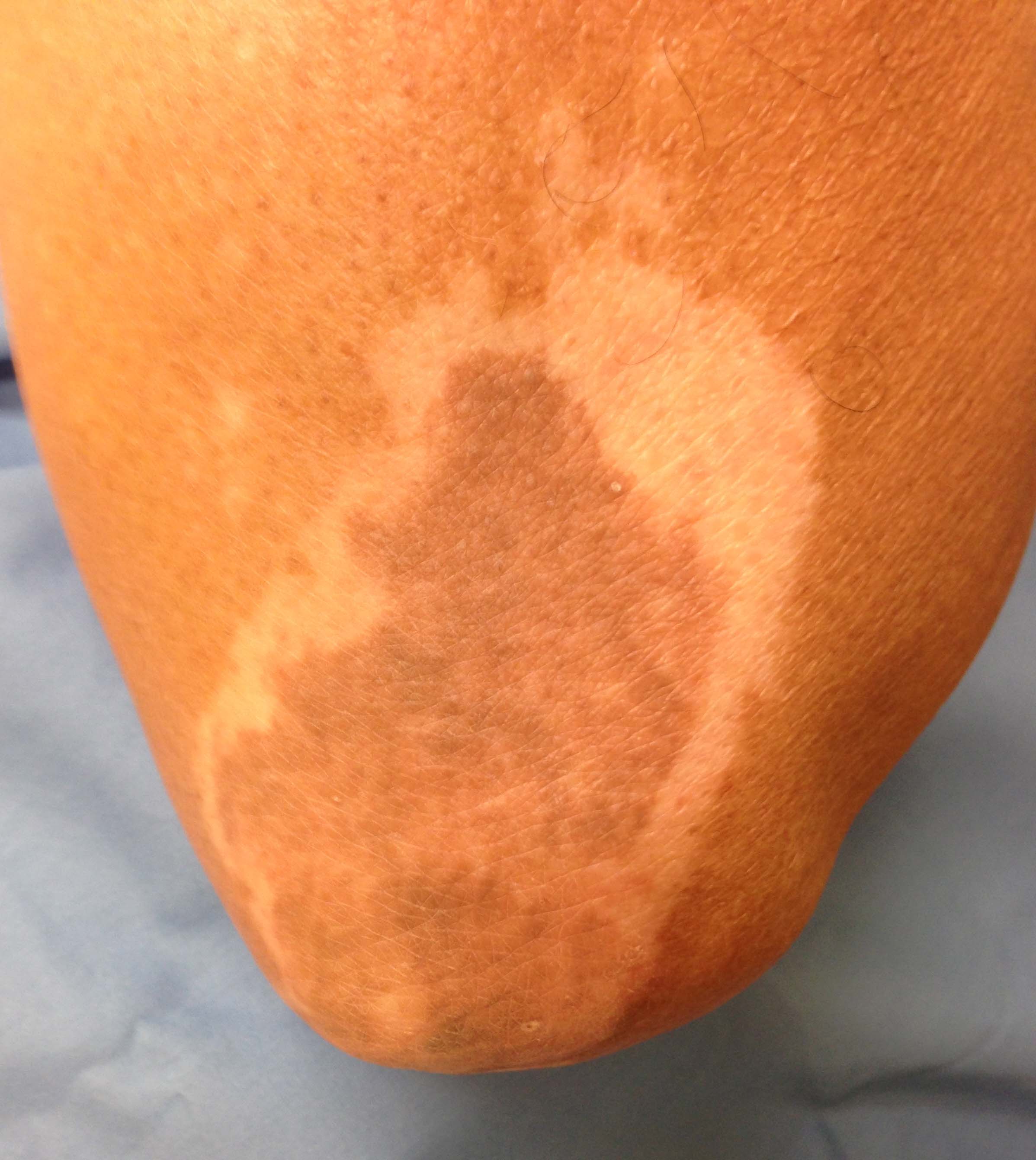 Should someone with vitiligo get a tattoo? The answer is not straightforward, and requires some discussion about the purpose of the tattoo, the stability of vitiligo, and the expectations of the patient. Some people want to tattoo a vitiligo spot with their skin color, so that it covers the spot and their skin looks even. Others want to tattoo a picture or phrase over their spots to serve as a distraction, and others just want to get a tattoo on a part of the body that doesn’t have spots, but they heard that it might make their vitiligo worse. I will address all of these options here, as well as their pros and cons.
Should someone with vitiligo get a tattoo? The answer is not straightforward, and requires some discussion about the purpose of the tattoo, the stability of vitiligo, and the expectations of the patient. Some people want to tattoo a vitiligo spot with their skin color, so that it covers the spot and their skin looks even. Others want to tattoo a picture or phrase over their spots to serve as a distraction, and others just want to get a tattoo on a part of the body that doesn’t have spots, but they heard that it might make their vitiligo worse. I will address all of these options here, as well as their pros and cons.
First of all, for a number of reasons it is usually a bad idea to try to tattoo the color of your skin over a vitiligo spot to hide it. It is very difficult to match the color of your skin with tattoo ink, partly because the skin color changes with the seasons, sun exposure, and age. But also, the color of ink tattooed deep into the skin is altered significantly when light travels from the ink, through layers of the skin, to your eye (the Tyndall effect). So whatever color you select for the tattoo, it will look a lot different once it’s placed into the deep skin (the dermis) through a tattooing needle. Another problem is that the vitiligo spot may get larger with time, and so even if the color match were perfect, the spot may grow, creating a ring of white skin around the tattoo, which won’t do much to help hide the vitiligo (see above, image used with permission).
 Alternatively, I have seen many patients with tattoos over their vitiligo spots that are interesting pictures or phrases that become a distraction from the white spots, and these often work well. For example, one patient had the phrase “You are beautiful” tattooed over her vitiligo. Another person tattooed PRIDE on her back, with a purple ribbon representing vitiligo awareness as the “I” (see right, images used with permission). This approach does not depend on matching the skin color or shape of the spots, so it can work well. However any trauma or damage to the skin, including puncturing the skin with a tattoo needle, can worsen vitiligo at the site, or create a new vitiligo spot. This process is called koebnerization, which is common to see on the knees of children with vitiligo, for example, because they often fall, scrape their knees, and vitiligo appears. Another patient I saw with this was an avid mountain biker, who frequently banged up his legs, and had many vitiligo spots up and down his shins. This may or may not happen if you have vitiligo and get a tattoo, but it is more likely to happen if your disease is actively spreading, such that you are getting new spots or your old ones are getting larger. It is a particular risk if you tend to get vitiligo spots where your skin is damaged, from a burn or a cut, for example.
Alternatively, I have seen many patients with tattoos over their vitiligo spots that are interesting pictures or phrases that become a distraction from the white spots, and these often work well. For example, one patient had the phrase “You are beautiful” tattooed over her vitiligo. Another person tattooed PRIDE on her back, with a purple ribbon representing vitiligo awareness as the “I” (see right, images used with permission). This approach does not depend on matching the skin color or shape of the spots, so it can work well. However any trauma or damage to the skin, including puncturing the skin with a tattoo needle, can worsen vitiligo at the site, or create a new vitiligo spot. This process is called koebnerization, which is common to see on the knees of children with vitiligo, for example, because they often fall, scrape their knees, and vitiligo appears. Another patient I saw with this was an avid mountain biker, who frequently banged up his legs, and had many vitiligo spots up and down his shins. This may or may not happen if you have vitiligo and get a tattoo, but it is more likely to happen if your disease is actively spreading, such that you are getting new spots or your old ones are getting larger. It is a particular risk if you tend to get vitiligo spots where your skin is damaged, from a burn or a cut, for example.
 So in summary, if you have vitiligo and you’re thinking about getting a tattoo, consider a few things first. It is rarely a good idea to try to tattoo a vitiligo spot the same color as your skin, because the color will not likely match exactly, the color of the skin changes, and the spot may get larger. If your vitiligo is active (you’re getting new spots, old ones are getting larger, or spots appear when you damage your skin), a tattoo might make it worse, or cause a new spot. But many people with vitiligo have chosen to get a tattoo with good results. It is not likely that the tattoo ink itself will fade with vitiligo, since vitiligo is not lightening of all color, but loss of the color-producing cells called melanocytes. So tattoo ink shouldn’t be affected by vitiligo. Just for fun, I’ve included a picture of someone who highlighted her vitiligo by outlining the borders of her spots in pen! It’s another perspective, where she decided that her vitiligo was art in itself (see left, image used with permission). In the end, the decision is up to you, and if you decide it’s worth the risk to get the tattoo, have fun with it!
So in summary, if you have vitiligo and you’re thinking about getting a tattoo, consider a few things first. It is rarely a good idea to try to tattoo a vitiligo spot the same color as your skin, because the color will not likely match exactly, the color of the skin changes, and the spot may get larger. If your vitiligo is active (you’re getting new spots, old ones are getting larger, or spots appear when you damage your skin), a tattoo might make it worse, or cause a new spot. But many people with vitiligo have chosen to get a tattoo with good results. It is not likely that the tattoo ink itself will fade with vitiligo, since vitiligo is not lightening of all color, but loss of the color-producing cells called melanocytes. So tattoo ink shouldn’t be affected by vitiligo. Just for fun, I’ve included a picture of someone who highlighted her vitiligo by outlining the borders of her spots in pen! It’s another perspective, where she decided that her vitiligo was art in itself (see left, image used with permission). In the end, the decision is up to you, and if you decide it’s worth the risk to get the tattoo, have fun with it!